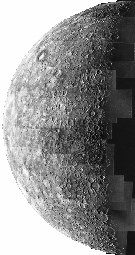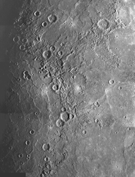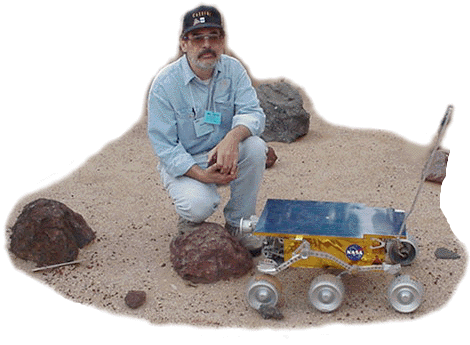





Mercury (NASA)
Mercury (SEDS)
Mariner 10
MESSENGER

| Volume 7 Issue 05 | May 2001 | |
| More on the Planet Mercury | ||
 While Pluto may be
the only planet we have not yet explored, the planet Mercury, several times
closer than Pluto, has barely been explored either. What we know about the
planet closest to our sun comes from Earth-based observations and only one
fly-by mission, Mariner 10. The Mariner 10 spacecraft, launched in 1973 used a
gravity assist from Venus to steer it into an orbit that would take it around
the sun and fly past Mercury three times between 1974 and 1975. While Pluto may be
the only planet we have not yet explored, the planet Mercury, several times
closer than Pluto, has barely been explored either. What we know about the
planet closest to our sun comes from Earth-based observations and only one
fly-by mission, Mariner 10. The Mariner 10 spacecraft, launched in 1973 used a
gravity assist from Venus to steer it into an orbit that would take it around
the sun and fly past Mercury three times between 1974 and 1975.
The Mariner 10 has been the only spacecraft to visit Mercury. The Mariner 10 mission included instruments designed to study Venus and Mercury's atmosphere, surface features, and physical characteristics. The spacecraft used a television camera for photography, and used its science detectors for a variety of observations including magnetic fields, plasma, infrared radiometry, ultraviolet spectroscopy, and radio science. During the time of the three fly-bys of Mercury the Mariner 10 spacecraft mapped approximately 50% of the planet surface and discovered the presence of a very thin atmosphere and a magnetic field. What we have learned about Mercury has revealed a planet of extremes. Imagine a planet with an orbit eccentric enough such that at perihelion (46 000 000 km) Mercury is almost twice as close as during aphelion (70 000 000 km). This is a planet with daily surface temperature that range from -200oC to about 400oC. This temperature swing allows Mercury, at times, to be one of the coldest surfaces in the solar system, and then be nearly as warm as the surface of Venus. (continue reading article) |
|
There is even an atmosphere of sorts, one created by the effects
of the solar wind on the surface. Atoms are energized enough to leave the surface
however they can easily escape into space.
Up until the early 1960's it was believed that Mercury did not rotate, or if it did it was like our moon where the rate of rotation is approximately equal to the rate of revolution. Studies using Doppler radar techniques revealed a planet that was rotating, however it is so slow that one Mercurean day, equal to 176 Earth days, is exactly twice as long as one Mercurean year, equal to 88 Earth days. With a rotation and revolution ratio like this combined with a highly eccentric orbit the daily path the sun would take with respect to the horizon would be very strange indeed. During perihelion Mercury would move faster along its orbital path than when further away from the sun during aphelion. The sun would not just rise and set with a regular apparent motion as we have on our planet with a much more circular orbit, but rather a day on Mercury would have a sun moving across the sky at varying speeds, and at times coming to a stop, or even reversing directions.  From images returned
by the Mariner 10 spacecraft we saw that the surface of the planet was pockmarked
with many of craters, some of which appeared to be lava-flooded impact basins
such as those we see on the surface of our moon and Mars. One particular striking
crater, the Caloris Basin, is about 1 300 km in diameter. Much of the surface of
Mercury and many of the craters are cut across by very large escarpments, some of
which were hundreds of kilometers in length and several kilometers deep.
From images returned
by the Mariner 10 spacecraft we saw that the surface of the planet was pockmarked
with many of craters, some of which appeared to be lava-flooded impact basins
such as those we see on the surface of our moon and Mars. One particular striking
crater, the Caloris Basin, is about 1 300 km in diameter. Much of the surface of
Mercury and many of the craters are cut across by very large escarpments, some of
which were hundreds of kilometers in length and several kilometers deep.
|
 These Articles, activities, and the monthly newsletter may be reproduced for classroom use; inclusion in another newsletter,
or linked with another web site, without written permission. Any other use will require written permission.
These Articles, activities, and the monthly newsletter may be reproduced for classroom use; inclusion in another newsletter,
or linked with another web site, without written permission. Any other use will require written permission.